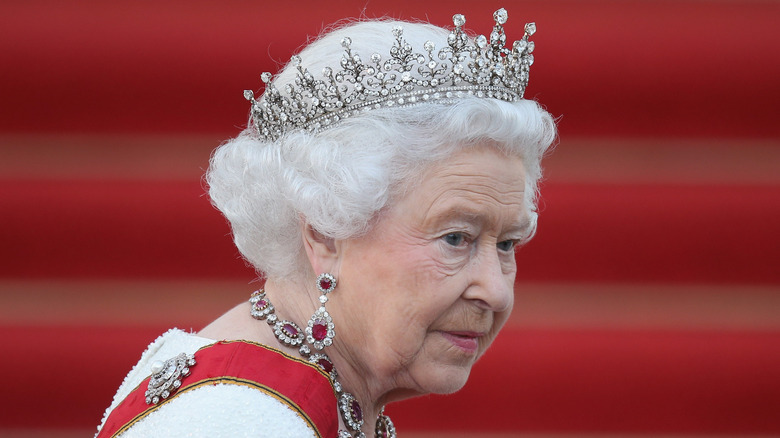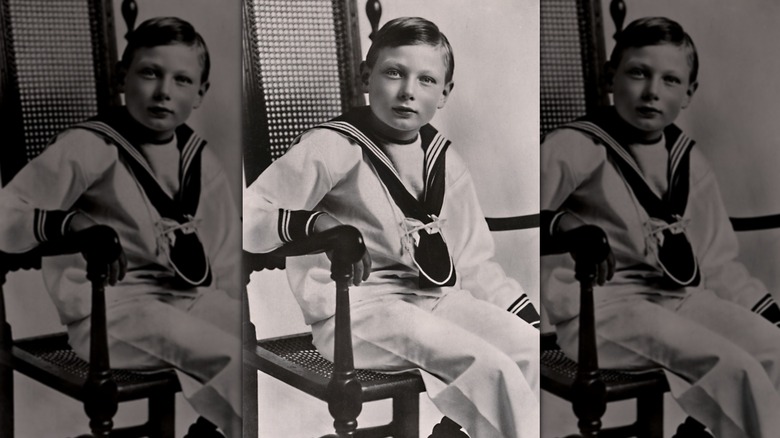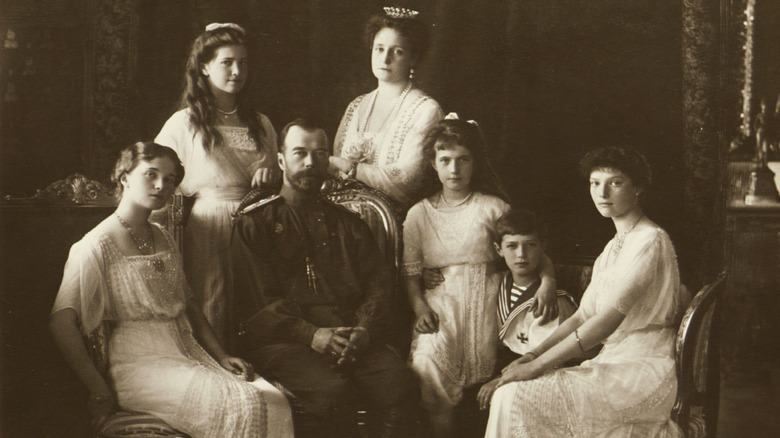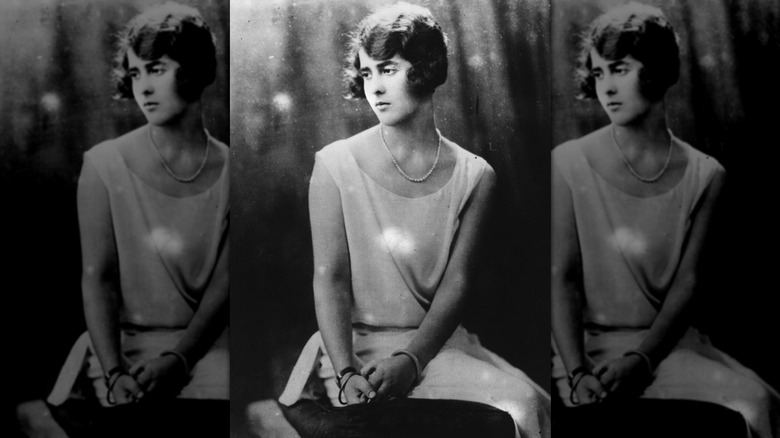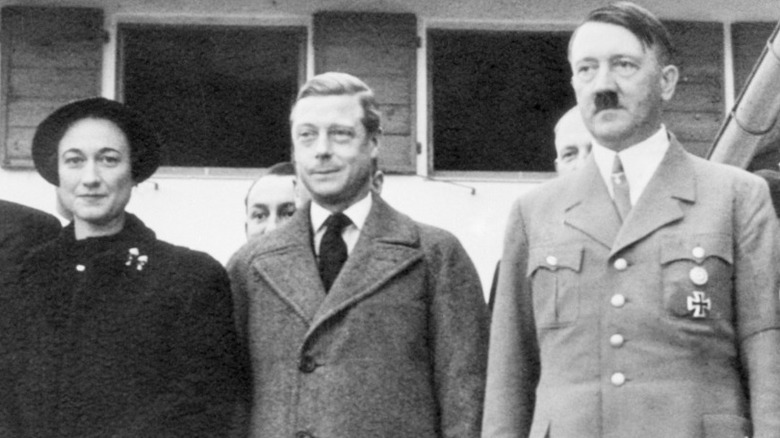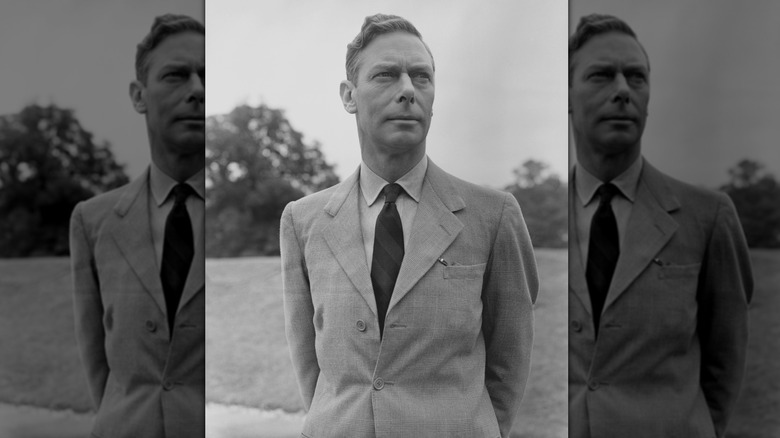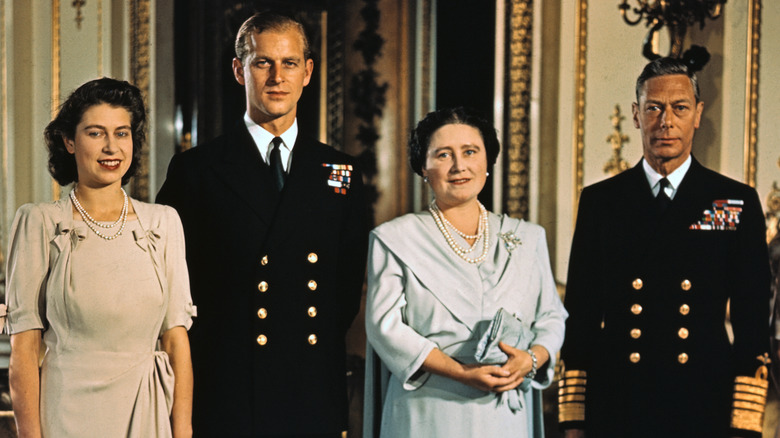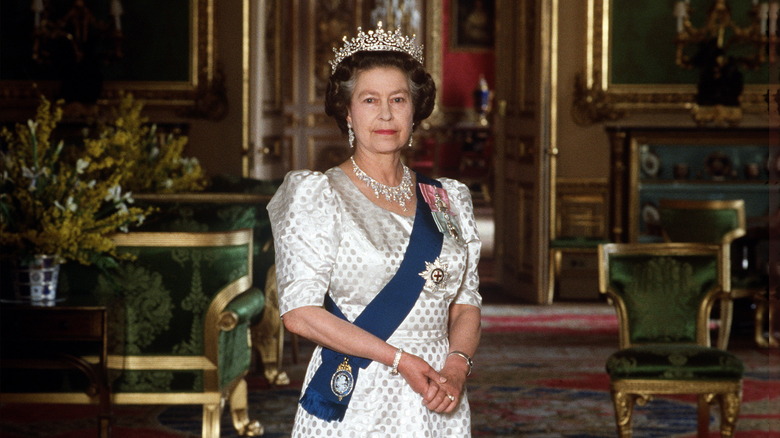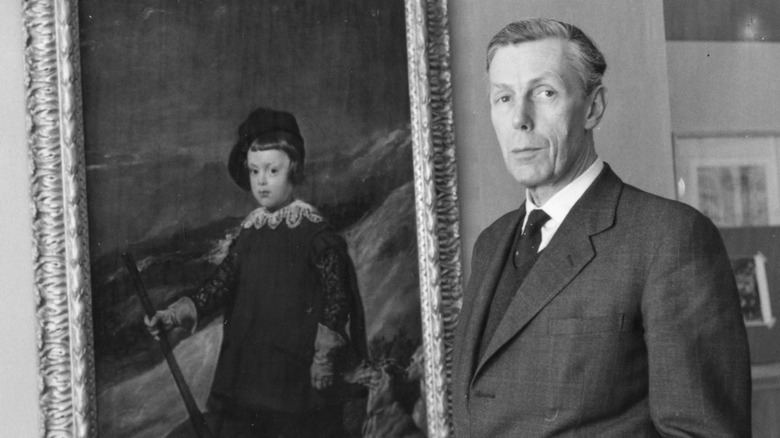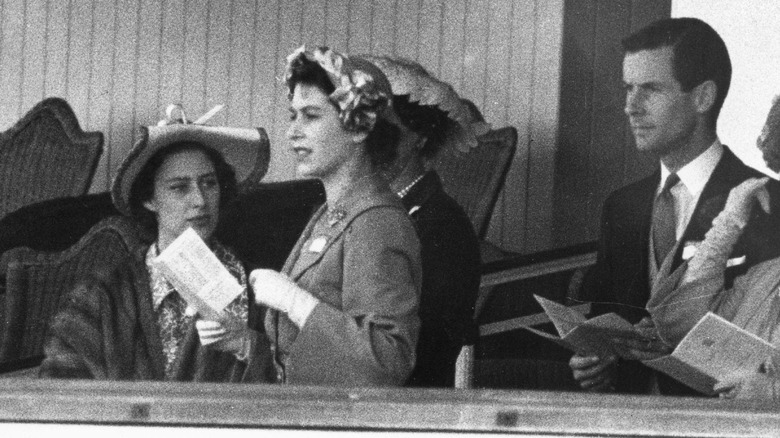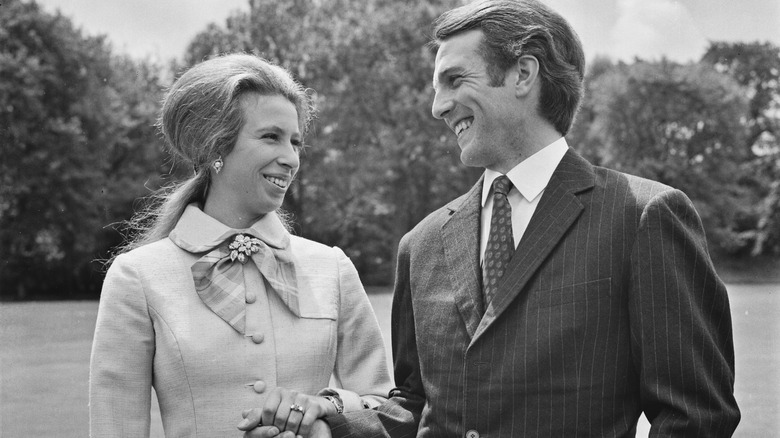Secrets That The Royal Family Tried To Hide From The Public
The royal family sure tries to present itself as a group of perfect people. From their expensive clothing to the trips they take and the people with whom they associate, everything has a shiny veil, making it seem as though all is well. But it is just a veil, and when removed, it's clear that the royal family is just as dysfunctional as any other family ... perhaps even more.
It shouldn't be too surprising, though. Britain has had a monarchy for centuries, with the Windsors in power since 1901, so one family with that much money and influence is bound to have some issues. Understandably, most families would want to keep certain issues to themselves. Unfortunately for the royal family, the public takes a unique interest in their personal lives, and certain aspects are just too difficult to keep private despite their considerable means. If there's anything more powerful than money, it's secrets, and these ones were impossible for the royal family to keep.
King George V hid his youngest son
Just because the royal family has influence does not mean they're above the harmful attitudes of the general population. In the early 1900s, people with disabilities and those related to people with disabilities were looked down upon. Most families did not have the money to hire full-time staff to care for their relatives with a disability, but the royal family did.
King George V, Queen Elizabeth II's grandfather, had six children. His most well-known children were Edward VIII and George VI, given they were both the King of England at one time, but his least-known son was Prince John, the youngest child. Prince John suffered from epilepsy, and some believe he may have had autism, as well. Because of his neurodiversity, George V kept his son from attending various public events, such as his coronation, and stopped sending him to formal school. The royal family provided John with a caretaker, Charlotte "Lala" Bill, who lived with him at Wood Farm on the Windsors' Sandringham Estate.
When John was 13, he died from a seizure. Upon his death, Queen Mary, John's mother, wrote, "A great shock, tho' for the poor little boy's restless soul, death came as a great relief. [She] broke the news to George and [they] motored down to Wood Farm. Found poor Lala very resigned but heartbroken. Little Johnnie looked very peaceful lying there" (via Express).
King George V potentially could have saved the Romanovs
The demise of the Romanovs, the last imperials of Russia, is tragic for many reasons, but it becomes far more tragic when learning that their lives could've been spared had royals across Europe gotten more involved. Like many European royals of the time, King George V was cousins with Nicholas II and his wife Alexandra, the last tsar and tsarina of Russia. Near the end of Nicholas' reign, Russia was experiencing massive political upheaval, which resulted in the Romanovs' exile and ultimate execution. Nicholas and Alexandra, of course, knew that their days in power were numbered and they called upon various royal relatives, including King George, for help escaping Russia.
At the time of the Russian Revolution, major countries in Europe, including Russia and Britain, were involved in World War I. George V initially accepted an offer to help the Romanovs flee, but because of various political reasons, he retracted, and the Romanovs were subject to the Bolsheviks. After Nicholas, Alexandra, and their children were killed, Britain sent for any remaining relatives and helped them escape. When the truth came out, it seemed too little too late for some, but others think George was unfairly judged. "I think he's been scapegoated for too long. [Not to] exonerate King George, not at all. He had a role he could have played more effectively ... But the chips were down and they had to choose," said Romanov expert Helen Rappaport (via History).
Prince Philip's sisters married Nazis
While figures like Pippa Middleton and the strained relationship between Meghan Markle and her father are widely reported on in the media, most relatives of royals who have married into the institution are kept out of the public eye, and that might be by design. Not all of them have savory pasts, such as Prince Philip's sisters.
Prince Philip entered the royal family when he married Queen Elizabeth II in 1947. He came from a family of Greek aristocrats, and his sisters went on to lead very interesting lives.
One of Philip's sisters, Princess Margarita of Greece and Denmark, became a princess herself by marrying the German aristocrat Gottfried, Prince of Hohenlohe-Langenburg. Gottfried also had ties to other imperial families having been the great-grandson of both Queen Victoria and Tsar Alexander II. Gottfried fought in World War II as a Nazi after enlisting in 1937, but dropped his allegiance to Adolf Hitler when he became part of a plan to overthrow the dictator. Gottfried died in 1960 and Margarita lived until 1981. Prince Philip's other older sister, Princess Sophie of Greece and Denmark, was also married to a Nazi, Prince Christoph of Hesse. Sophie and Christoph had a much closer relationship to Hitler — the two shared meals with him and even named one of their children after him. Christoph died just before the end of the war and Sophie lived until 2001.
Edward VIII was close to Adolf Hitler
The royal family has weathered unbelievable storms throughout history. In the 20th century alone, it managed economic collapse, disease, major shifts in power, and multiple world wars. World War III was particularly difficult for the royal family as one of its own had a close relationship with one of the greatest villains of all time, Adolf Hitler. Edward VIII, the man who abdicated the throne to marry Wallis Simpson, was good friends with Hitler, even during the darkest times of his reign. Although the world knew that Edward had a relationship with Hitler, it wasn't known exactly how close that relationship was until much, much later.
News of Edward's ties to Hitler came after the two were photographed together, along with Simpson, in the late 1930s. The friendship with Hitler continued to be beneficial for Edward and Simpson. During the war, many people throughout Europe, especially those living in countries under German occupation, struggled economically and didn't have enough to eat. However, Edward VIII and Wallis Simpson were taken care of as Hitler reportedly made it possible for the couple to travel to Portugal to live in a mansion.
"We all knew all these rumours about the Duke of Windsor and his sympathies to Hitler and Germany, but nobody really established the facts of what really was going on," Portuguese journalist Paulo Anunciação said in "Edward VIII: Britain's Traitor King," as reported by CBC.
King George VI ordered intel on his brother
Edward VIII's relationship with Adolf Hitler and the royal family's anger over it reportedly goes far deeper than just escaping to a mansion in Portugal. King George VI, Edward's brother who assumed the throne when he abdicated and Queen Elizabeth II's father, ordered M15, Britain's military intelligence agency, to look into his brother.
The king worried that Edward's relationship with Hitler was potentially harmful to Britain and the Allies' efforts to defeat Nazi Germany. Prime Minister Winston Churchill was even involved as he learned that Edward and his wife, Wallis Simpson, had asked some prominent American citizens to try and convince President Roosevelt to stay uninvolved in World War II. "The Duke and Duchess of Windsor imploring important Americans not to join the war on Britain's side, it's astonishing. It's close to treachery actually," Professor Richard J. Aldrich told Express on the matter.
The ordered intelligence on Edward and Simpson followed them to the United States. While in Miami in 1941, Roosevelt had the FBI watch the couple. It was also reported that Edward and Simpson were upset with the royal family, particularly King George, for the Windsors' treatment of them after Edward abdicated the throne, and some feared that if the Nazis invaded Britain, they would stage a coup to restore Edward as king. That, of course, did not happen, and seven years after the war ended, George died and Elizabeth became queen.
King George VI was hesitant for his daughter to marry Prince Philip
Everybody wants to make a good impression on their future in-laws, but there's extra pressure when your future in-laws are royalty. Queen Elizabeth and Prince Philip met when Philip gave Elizabeth and Princess Margaret a tour of Britannia Royal Naval College in Dartmouth. Elizabeth became smitten with Philip, keeping correspondence with him for years afterward. Though Elizabeth's feelings for Philip were not initially reciprocated, he eventually fell in love with her, and in 1946, he proposed.
Despite the couple's excitement over the engagement, Elizabeth's parents, particularly her father, King George VI, were not thrilled. "The thought that he might become a son-in-law was most unwelcome. Why wasn't she marrying some respectable English duke? Yes, he was a Prince of Greece and Denmark. But very suspect, Greece — they get rid of their royal families regularly. And he had no money," Lady Pamela Hicks told Vanity Fair of the situation.
Indeed, Prince Philip did not have much to offer Elizabeth. He did have a title, but it was essentially worthless as his uncle, King Constantine I, had been forced to abdicate the throne of Greece and the family was exiled. George worried about the optics of his daughter marrying someone from such a family, and he reportedly didn't like Philip's personality either. The British media learned about Philip and Elizabeth's relationship, though, and it became difficult for the royal family to continue hiding its disapproval.
Queen Elizabeth's cousins with disabilities were hidden from the public
Some royal family secrets are scandalous. Some are too shocking for words. Others are just plain dark. Queen Elizabeth II's mother had two nieces with severe disabilities, Nerissa and Katherine Bowes-Lyon. Their exact disabilities are not known, but those who knew the sisters said they were non-verbal. Mental disability and mental illness were not widely recognized or understood at the time but were seen as a castigation of a family, which is likely why neither was given a formal diagnosis and is said to be why the royal family did not publicly acknowledge their existence.
Nerissa and Katherine lived at the Royal Earlswood Asylum for Mental Defectives in Surrey, England for most of their lives. "It was so sad. Just think of the life they might have had. They were two lovely sisters," Onelle Braithwaite, a nurse at the facility, said of the girls in a 2011 documentary (via the Daily Mail). "Today they'd probably be given speech therapy and they'd communicate much better. They understood more than you'd think."
While Nerissa died in 1986, Katherine lived until 2014. Both, however, had been reported as dead by Burke's Peerage in 1963. Their father, John Herbert Bowes-Lyon, died in 1930, reportedly heartbroken over Nerissa and Katherine's disabilities.
Queen Elizabeth II knowingly employed a Soviet spy
This secret of the royal family is a little difficult to wrap the mind around at first. For decades, Anthony Blunt was employed by the royal family as an art curator. Blunt was English by birth and had a personal relationship with Queen Mary. He had progressive views on social issues and was staunchly opposed to Adolf Hitler's beliefs. But he had one flaw that most would've thought fatal: he was a Soviet spy. Surely, this had to have been something the crown was completely unaware of and didn't learn until much later? Wrong. Everyone at Buckingham Palace knew, even Queen Elizabeth knew, that Blunt was a KGB agent.
So why did the royal family keep Blunt employed despite knowing he was a potential threat? It's been reported that Blunt did lots of dirty work for the royal family, and from the nature of his work, he learned even deeper secrets that could've been harmful had they been made public. Beyond that, the family was happy with his on-the-books work. Blunt was so venerated by the royal family as Surveyor of the King's Pictures that he was eventually knighted. Blunt wasn't able to keep things up forever, though. Eventually, M15, Britain's military intelligence, siphoned Soviet information from him in exchange for immunity. Then, in 1979, Prime Minister Margaret Thatcher shared with the public that Blunt was a Soviet spy. About four years later, Blunt died.
Princess Margaret wanted to marry a divorced man
It's a tale as old as time — a young royal wants to marry someone they love, but something is standing in the way of their romance. It's so pervasive that even mermaids have experienced this plight. Some royals deal with this issue by relinquishing their titles and all access to anything afforded to them by their family, but others maintain their royal status and give up their lover. Princess Margaret did the latter.
Princess Margaret, Queen Elizabeth II's sister, fell in love with Peter Townsend, a divorcé. Because he had been previously married, the royal family did not approve of Margaret's relationship, and the crown attempted to keep it hidden from the public.
Margaret and Townsend's love was too great to hide, though. At Elizabeth's coronation, Margaret brushed lint off Townsend's shoulder, indicating to the public that they were intimately involved. Their relationship continued for a few years after, even resulting in an engagement. However, it ultimately ended, with Margaret issuing a statement to the public. "Mindful of the Church's teaching that Christian marriage is indissoluble, and conscious of my duty to the Commonwealth, I have resolved to put these considerations before any others," Margaret said (via the Daily Mail). The princess went on to marry Antony Armstrong-Jones and even kept that relationship a secret for a while, too.
Princess Anne and her husband were both unfaithful
Royal relationships have always been interesting. In 1973, Princess Anne, Queen Elizabeth and Prince Philip's daughter, married Captain Mark Phillips. The royal couple had two children together, Peter and Zara, but they ended up separating in 1989. Rumors had swirled for years before their separation that the two were experiencing marital issues, but the crown kept the truth under wraps.
The truth is that both Anne and Phillips had been unfaithful to one another. Phillips' infidelity, however, resulted in a more permanent consequence. While he was still married to Anne, Phillips fathered a child with another woman, a New Zealand native named Heather Tonkin.
Mark Phillips was adept at keeping the information secret. He paid Tonkin £6,000 a year to support the child, claiming it was a payment for Tonkin's work as an equestrian consultant. Tonkin did not intend to make her child's paternity public — she had her child believing her father was dead — but in 1991 she chose to bring forth the story because Phillips had stopped making payments. "I wish I could wake up one morning in the knowledge that the record had been put straight and I don't have to worry anymore," Tonkin told Express of the ordeal. After a paternity test proved what Tonkin already knew, Phillips paid her £350,000 for his daughter's welfare. Phillips went on to wed again, but that marriage failed after he had another affair.

